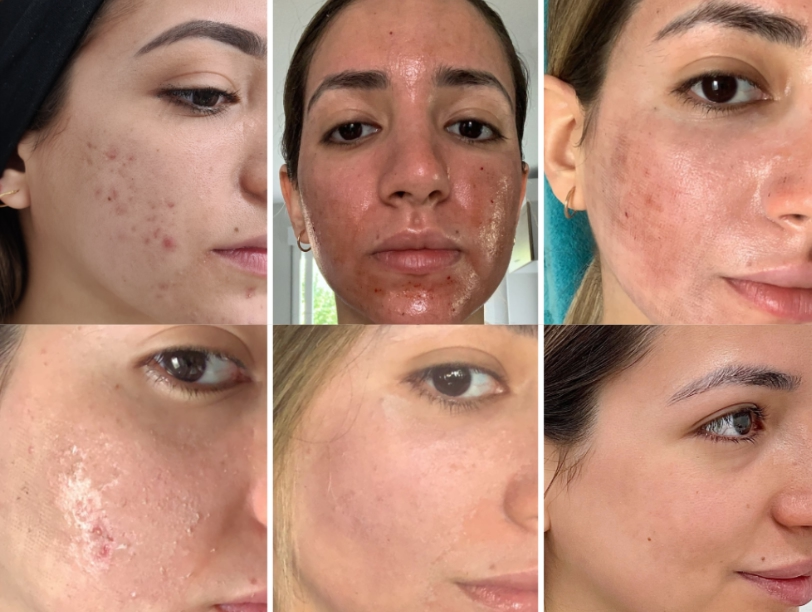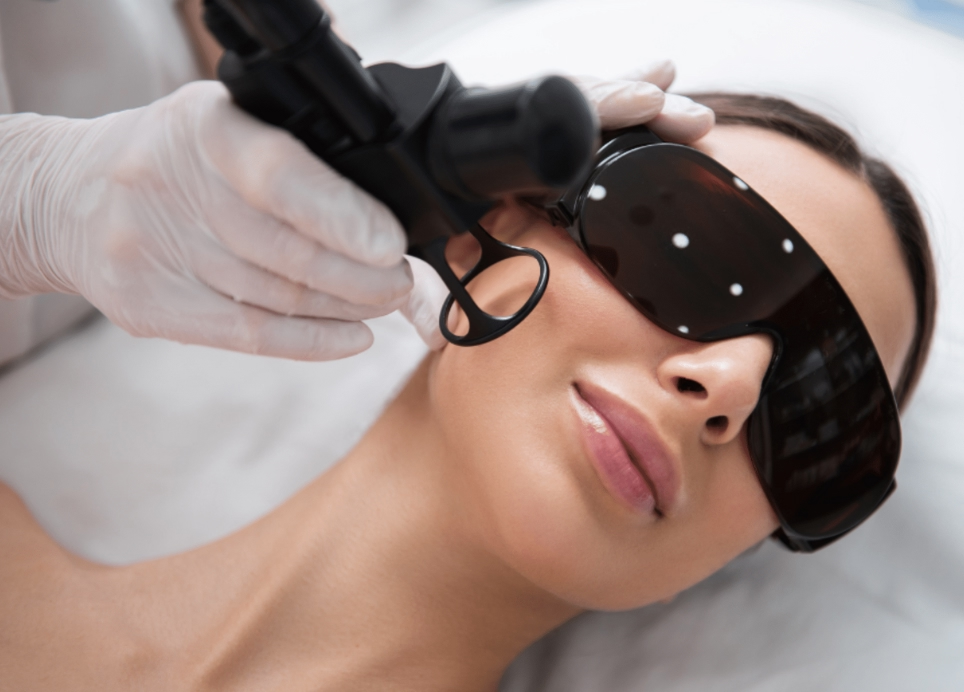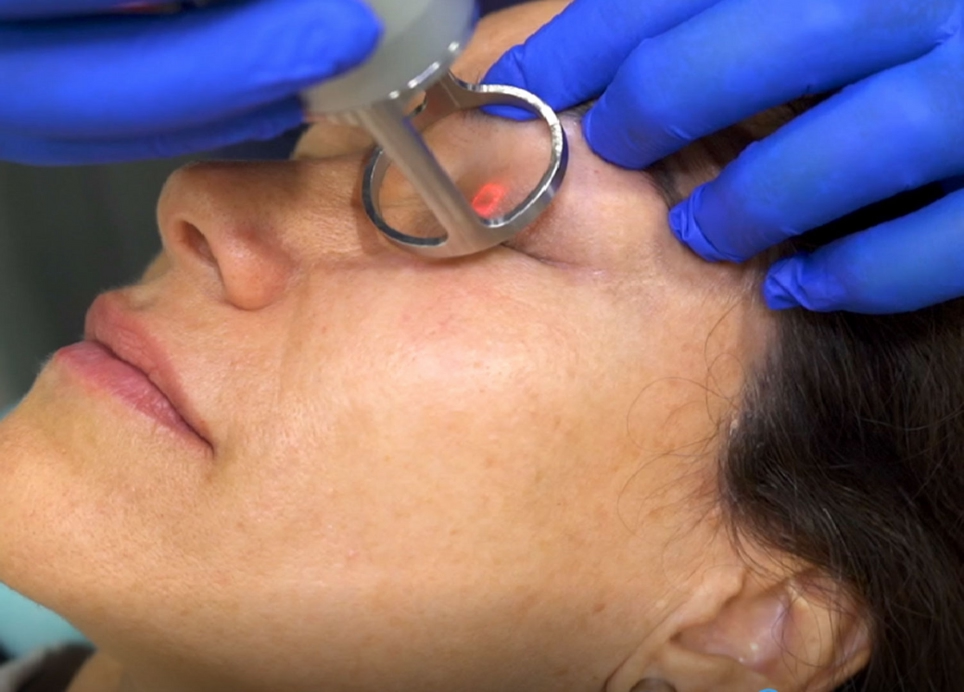Ultrasound system
Generates 4-7 MHz waves that penetrate up to 4.5mm depth without affecting the surface skin
Fractional CO2 laser is the most advanced technology in aesthetic medicine for deep skin renewal, scar removal and complete facial rejuvenation.

It combines the ablative power of traditional CO2 with the safety of fractional technology to achieve results that were previously impossible.
Learn how we perform your Fractional CO2 Laser treatment at ALMO Clinic. Schedule your specialized medical evaluation at no cost.
Fractional CO2 Laser in ALMO ClinicUnderstanding the science behind why this technology surpasses all available alternatives.
Generates 4-7 MHz waves that penetrate up to 4.5mm depth without affecting the surface skin
Distributes heat uniformly instead of concentrating it in single painful points
Protects epidermis while treating deep layers where structural collagen is produced

The process develops in microseconds but its effects last months:
Instant absorption: The 10,600nm energy is absorbed by water molecules in epidermis and dermis. This absorption is 10,000 times more efficient than nearby infrared wavelengths.
Controlled vaporization: Water instantly converts to vapor expanding cellular volume 1000 times. This creates controlled micro-explosions that remove damaged tissue layer by layer.
Coagulation zone: Around each ablative microcolumn forms a 50-100μm thermal coagulation zone. This immediately stimulates contraction of existing collagen.
Controlled protein denaturation: Dermal proteins are denatured in a controlled manner, initiating the repair cascade that will lead to new collagen synthesis.
Immediate activation: Fibroblasts detect "controlled damage" and activate genes for production of new type I, III collagen and elastin.
Progressive remodeling: During 3-6 months, new collagen organizes into denser and more organized patterns, improving firmness, texture and overall appearance.
Why fractional technology revolutionized aesthetic laser medicine and changed the rules of the game.

Specific conditions where this technology demonstrates superiority vs alternatives.
3x deeper than standard fractional laser. Reaches reticular dermis where structural collagen is formed.
24 independent microneedles with individual depth control. Zero energy dispersion vs diffuse heat technologies.
Unique treatment approved FDA for all I-VI skin phototypes. Zero risk of hyperpigmentation with correct protocol.

Technical analysis of why fractional CO2 surpasses other options in multiple parameters.
| Condition | Fractional CO2 | Fraxel 1550nm | IPL | TCA Peeling |
|---|---|---|---|---|
| Deep scars | Excellent (85% improvement) | Good (45% improvement) | Limited (15% improvement) | Moderate (35% improvement) |
| Deep wrinkles | Excellent (70% improvement) | Moderate (40% improvement) | Limited (20% improvement) | Good (50% improvement) |
| Dilated pores | Excellent (60% reduction) | Moderate (35% reduction) | Limited (15% reduction) | Good (40% reduction) |
| Sun spots | Excellent (90% removal) | Good (60% improvement) | Good (65% improvement) | Excellent (85% improvement) |
| Recovery time | 4-7 days | 2-3 days | 0-1 day | 7-14 days |
Technical conclusion: Fractional CO2 offers the best overall efficacy with acceptable recovery time. Unique technology that effectively treats multiple conditions simultaneously.
Determining factors for the success of fractional CO2 laser treatment.
Favorable factors for treatment:
Cases needing detailed medical assessment:
Situations where treatment is not recommended:
What to expect in each phase of the post-CO2 laser skin renewal process.
Appearance: Moderate redness similar to intense sunburn
Sensations: Slight heat sensation, mild tightness
Care: Cold compresses, soothing creams
Activity: Relative rest, avoid intense efforts
Appearance: Fine micro-scabs formation, mild flaking
Critical care: Intense hydration, gentle cleansing, absolute sun protection
Prohibitions: No scratching, no makeup, no intense exercise
Normalization: 70% of patients return to work on day 4-5
Initial improvements: Smoother texture, evident pore reduction
Deep changes: New collagen synthesis onset
Makeup: Allowed from day 7 with specific products
Precautions: Maintain strict sun protection
Improvement peak: Month 3-4 when new collagen reaches maximum density
Cumulative benefits: Firmness, uniformity, luminosity
Stabilization: Final results evident at 6 months
Durability: Maintained effects 3-5 years with proper care
After understanding the science of fractional CO2 laser, if you consider it may be the solution for your skin needs, the next step is a specialized medical evaluation.
• Detailed skin type analysis and specific conditions
• Personalized protocol design with specific parameters for your case
• Complete process explanation of care and results timeline
• Baseline medical photography to document progress
• Transparent pricing with no surprises later
The evaluation has no cost and allows you to make a completely informed decision about whether fractional CO2 laser is the right option for your aesthetic goals.
Discover all fractional CO2 laser treatment options and transparent pricing.
View full pricesExplore other non-invasive and minimally invasive treatments available at ALMO Clinic.
View treatmentsAnswers to the most common questions about our services and aesthetic treatments.
View FAQMeet our certified specialists and their experience in aesthetic medicine.
Meet teamComplete medical evaluation to determine if fractional CO2 laser is the ideal option for your specific aesthetic goals.
Schedule evaluation